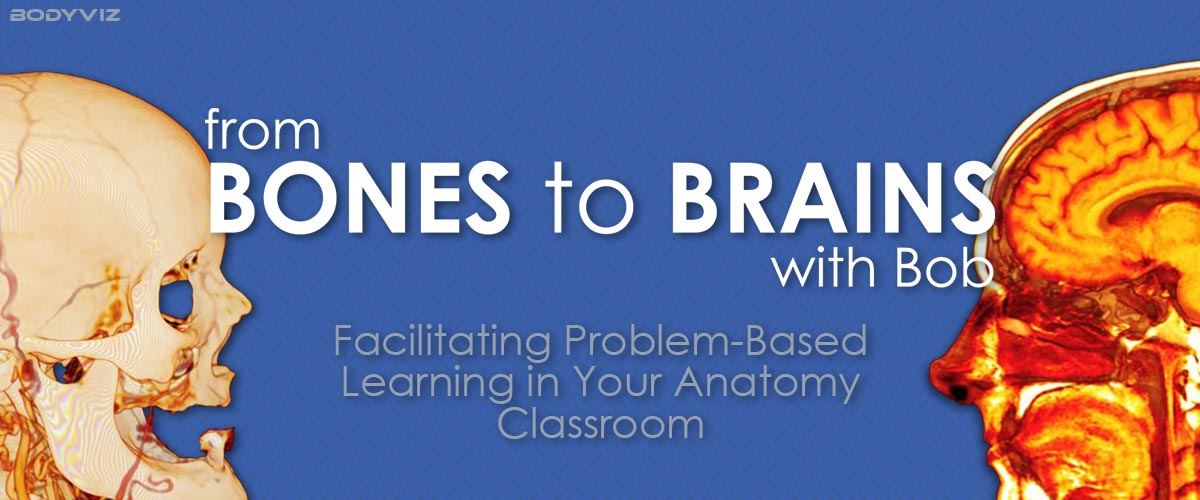Facilitating Problem-Based Learning in Your Anatomy Classroom
by Robert Tallitsch, PhD | January 6, 2020

During my career at Augustana I constantly worked to increase my students’ higher-order thinking skills and, therefore, their problem-solving skills. I did this by utilizing Problem-Based Learning, flipped classrooms, and high-quality anatomical software in my classes.
As some of you may have already seen, a recent discussion on the HAPS* (Human Anatomy and Physiology Society) listserv centered around increasing higher-order thinking skills in the anatomy portion of a combined Anatomy and Physiology (A&P) course. Most participants in this discussion felt this was much easier to do in the “P” portion of the course rather than in the “A” portion. Many also felt that the anatomy portion of their class involved mostly lower-order (rote memorization) thinking skills. As the discussion continued, I explained several teaching pedagogies that, when accompanied by the use of 3D anatomical software, could be incorporated into the “A” portion of their classes, thereby increasing students’ higher-order thinking and problem-solving skills. The Study of Teaching and Learning literature also indicates that these pedagogies, when combined with the use of high-quality anatomical software, significantly enhance higher-order thinking skills. Below is one example of a multi-part PBL that I used at Augustana.
Part One
Rachel is a 37-year-old who experiences a migraine as she is walking home. She notices a flashing aura in her peripheral vision, becomes increasingly sensitive to light, and is unable to tolerate even normal sounds. At home she pulls the blinds in her bedroom and settles into bed for the day. Two hours later Rachel awakens agitated, with an intense headache, difficulty speaking, and cannot feel her right side. Frightened, she dials 9-1-1 and requests an ambulance. The EMTs arrive, immediately place her on oxygen and rush her to the hospital.
Student Prompt: What is your diagnosis for the patient? Defend you answer with sound anatomical logic, including reference citations for sources utilized in your research of the problem.
Part two of the problem is distributed following my review and grading of the students’ diagnoses and anatomical logic for part one.
Part Two:
In the ER Rachel tells the attending physician that, upon awaking, she felt a sudden intense headache and then experienced difficulty speaking and could not feel her right side. The attending ER physician suspects a CVA (stroke) and a neurologist is called for a consult. The following patient information and physical examination results are obtained:
- Patient is 37-years old, an avid bird watcher, in excellent physical condition and of normal weight
- No smoking or alcohol abuse
- History of migraines
- Patient is under care of a cardiologist for atrial fibrillation
- Complete blood workup and full-head MRI are ordered
Neurological examination results:
- Pure hemisensory loss on the right side of the body. Pronounced sensory loss in the patient’s right hand and foot; less pronounced in the proximal portions of the right upper and lower appendages, as well as the right side of the trunk.
- No motor defects detected.
- The physician leaves the room and returns within two minutes. Rachel is unable to visually recognize the physician but is able to recognize the physician when he speaks.
- Rachel is unable to read a sign posted on the wall of the examining room, but is able to write her name without any difficulty.
- When presented with photographs of a Robin and a Downey Woodpecker Rachel is able to recognize the photographs as birds, but is unable to identify the specific type of bird.
Student Prompts
- Provide a detailed diagnosis of the patient and support your diagnosis with solid anatomical logic.
- List the parts of the brain involved in visual and auditory recognition of objects. Provide a detailed description of the structures listed.
- Provide a detailed anatomical description of the spinal tracts involved in Rachel’s sensory deficits in her upper and lower limbs.
- List the blood vessels that supply blood to the structures listed in questions 2 and 3 above.
- Outline the anatomy of the Circle of Willis and provide an explanation of the vessel or vessels that would supply blood to the parts of the brain listed in #2 above.
The correct diagnosis of the patient is a CVA affecting the VPL (ventral posterolateral nucleus) of the thalamus, causing the unilateral pure hemisensory loss. This is due to a CVA involving the thalamogeniculate branch of the posterior cerebral artery as visualized in 3D by BodyViz Software below.
It is simply impossible to cover every anatomical structure and fact in our classes. The PBL teaching pedagogy, particularly when paired with BodyViz, helps your students learn how to comprehend and apply what they have learned in order to solve complex, anatomical problems — all of which increases higher-order thinking skills in your students through increased faculty-student interaction and classroom participation.
*The HAPS listserv and the Open Forum Digest are open to all members of the Human Anatomy and Physiology Society and the American Association for Anatomy. Go to http://www.hapsweb.org and/or https://www.anatomy.org for information about these fantastic organizations focused on advancing anatomy education for students and educators.
Additional Articles